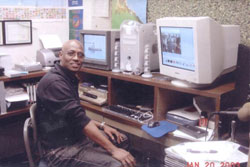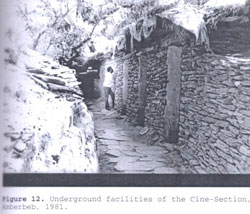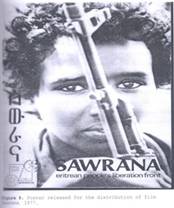

From: Berhane Habtemariam (Berhane.Habtemariam@gmx.de)
Date: Thu Feb 04 2010 - 18:07:52 EST
Documenting precious treasure for the future
Written by Samrawit Efrem |
04/02/2010
http://www.shabait.com/images/stories/0sam.jpgMr. Zarai Haile is one of the
freedom fighters-photographers during the armed struggle for liberation
period. The valiant photographers and fighters of the time sacrificed their
blood and toil to document the bravery and extraordinary feats of their
fellow fighters. Mr. Zarai was head of the cinema unit of the EPLF from 1983
- 1991 and had been present in almost all major wars at that time as a
cameraman. Having served in the same field for several years after
independence, Mr. Zerai moved to Washington DC where he launched the Voice
of Eritrea and Warsay TV in 1998 and 2000 respectively. Following are
excerpts of the interview he conducted with Shabait:
Q: Let's start with your background; can you tell us something about
yourself?
I was born in Asmara and attended school there till grade 7. I then moved to
Addis Ababa where I continued my studies till tertiary level where I
attended my first year of college studies at Addis Ababa University.
Unfortunately, civil unrest broke out during the Haileselasse regime and I
was compelled to terminate my studies. I moved to the US in 1971 where I
began studying mechanical engineering at the Agricultural and Mechanical
University of Alabama. I studied there until 3rd year. While I was there I
used to go to Washington D.C. quite often during semester breaks where there
was an active Eritrean political movement.
I was naturally easily influenced with the political atmosphere at that
time. I could say that I was involved in students' movement from an early
age, i.e., while I was in grade 10, and was closely following the political
movement of university students in Addis Ababa. By 1974, I was an active
member of the Association of Eritrean Movement in Washington.
Q: When and how did you join the Eritrean People's Liberation Front?
Up on the request of the EPLF in the field for volunteers who could take
short-courses on arts and electronic fields and then join the armed
struggle, I together with three others volunteered for the task. In 1975 we
attended classes in cinema institutions in New York for 6 months and joined
the armed struggle in 1976.
Q: When was the first time you took a picture in the fields?
http://www.shabait.com/images/stories/sewrana.jpgAfter we finished military
training we were immediately assigned to photograph the Zemach invasion.
Unfortunately the war ended before we could get there. So we were only able
to photograph Ethiopian prisoners of war. Thus, the first picture I took
using supper 8 cameras was of these prisoners in the Girhu Sirnay area.
Q: Can you tell us about the Photography Department of the EPLF when you
first joined it?
The information section was divided in to two branches in Fah and Baqos area
when I first become part of the photographic section. I was assigned in
Baqos to take photos of the activities in the highlands using both still and
motion cameras. Later on, the two sections were merged. We first began
producing films during the 1st congress of EPLF, using 16-millimeter
cameras. A cinematographic unit was formed in 1978, which was again
re-formed in the 1980s.
At that time we used to send negative pictures abroad for developing and
printing. But we established the first mobile laboratory of 16-millimeter
films in Arag. As time went by we began to acquire modern equipments. We
also trained a number of youngsters in 1983 with the help of the book I
prepared titled Elementary Cinematography. Furthermore, we exhibited
documentary and feature films to freedom fighters and civilians, which
helped them to stay connected with the outside world.
Q: How many films were produced before independence?
More than 40 documentary films including cultural films were produced. The
first documentary in black and white film was Sewrana, a one hour-long film
that was shot by 16 millimeter camera. Before that, a documentary film
titled Eritrea 74 was produced in 1973 by a French photographer. The first
color VHS film was produced in 1981. Moreover, about five feature films were
produced, the first of which was Eti kali'e Kunat (popularly known as
Kitaw).
Q: Are there moments you remember particularly from your days of a cameraman
before independence?
I have participated in a number of major wars but the most compelling was
the war in Massawa (Fenkil) in1990. I sustained an injury during one of the
battles but I was able to take good shots from the citadel, Forto, providing
a panoramic view of the port city, remains of Ethiopian soldiers as well as
the aftermath of the intensive bombings. Besides, other camera crewmembers
also took some strangely amusing pictures. Kibtset and Massawa documentary
films were produced from the shots we took during and after the Operation
Fenkil.
Q: Coming back to post independence period, tell us about what made you
launch the Voice of Eritrea and Warsay TV in Washington D.C?
http://www.shabait.com/images/stories/under.g-cinema.jpgI went to US in 1997
to continue my education and soon after, the border conflict with Ethiopia
broke out. Having no other source of information, but the western media.
Thus I decided to launch a one-hour radio program in Tigrigna, which had the
highest audience from other community radios in Washington DC area. I also
started Warsay TV that was distributed in six TV networks and in 2003 it won
the community television award.
Q: Can you tell us about your future plans?
I want to produce documentary films that can be handed down to generations
as forms of historical records. As yet, I have produced a music video on the
best songs of Helen Mele's until 2007 titled Helen Helena, another one on
combating desertification in Eritrea, and also about the Green-belt of
Eritrea, Semenawi Bahri, and Azel pharmaceuticals.
Thank you!





----[This List to be used for Eritrea Related News Only]----
